 |
  |
 |
  |
Postmodern meets Pre-Dravidian - Marc-Paul Lambert e-mail: sundara2004@yahoo.com Photos: Marc-Paul Lambert March 3, 2022 Borrowing movement from others What is new? What is contemporary? 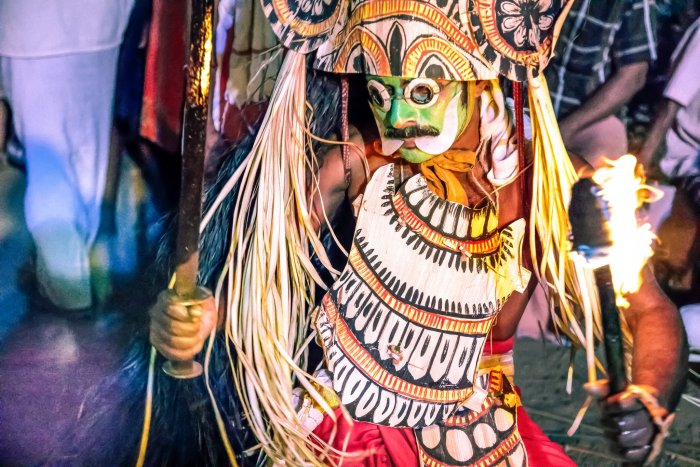 Kalan Kolam from Kadalimangalam, 2018 "The dancer today will seek to understand, refine, dig and especially make of his body a lucid and singular project." (Laurence Louppe 2003 [1] ) Borrowing movement from others It is remarkable to see how, some fifty years after Paris, the term "contemporary dance" settled in hotspots like Mumbai or Chennai [2] , breaking with semantics of Indian classical legacy. A catchy mood at first, it seems dancing contemporary could propel new choreographies everywhere on the planet, in original formats, although something déjà vu reminds us too of the legendary times of French Bagnolet "contests" (Chopinot, Découflé) - be it their bold manners; dancers shaking codes with irony, and their attraction to use space as on a playground (Galotta). Observing today how the dance scene evolved from a large perspective, the change "dancing contemporary" has brought to the embodiment of global models reveals to be far from being frivolous. Like a god creator, the artist decides either to pick up the movement material from the abstract, inventing coordinated phrases coming out of nowhere. He (or she) might ask the team to develop on found movements during improvisations. Creating a new feeling by moving adequately is not easy, but it should happen. It supposes you are altering although not intentionally, the audience's overall perception of the event, busy with collecting muscular and senses analogies. Spectators are figuring out on stage the plausible meanings conveyed by gestures between all parts. Work in progress may need to be cleared out from unnecessary affects. For that, the artist has built an emotional harmony to the piece by explaining his point with gestures, or a significant intonation, or by using a keynote one may rely on. Still the choice of actions, the speed, the "punctuation", the way hands are used may turn out to look absurd, since it doesn't make sense a priori, to alter the production and the nature of body signs at the place of anthropology foundations; or else it remains the most difficult option in dance ("Trio A", Yvonne Rainer, 1966), to read in the absence of a pure musical writing. There is a second possibility; dancing contemporary could entail you to work with an elaborated hand and footwork battery inspired from traditional rhythms, the source of regional dances. You can mix different techniques together, with the aim of altering body codes; introduce, for instance, yoga asanas and gymnastics into the Bharata Natyam language. The impact of gestures on sensibility will change into a new perception, although the sedimentation of other hieratic, minute details that were sculpted in body attitudes during generations could vanish for something else. Now if you really want to convey a new message from within, another vision of the dancing text does not involve a formal change of the genre. One may decide not to alter, ever, the Natya Sastra canon and even so, one would bring a different approach to interpretation. Suiting the genre to trends is a recurrent matter every generation learns to solve its own way. Without changing the rhythm, you can modify with a specific attitude the status of protagonists in representation. Actor Kottakal Sivaranam, an outstanding specialist of Kathakali feminine characters, amidst a strict hierarchical order imposed by the theatre genre, declared once he considered himself as an activist of women's cause. It was all in the expert manners he used. He was playing with the codes yet he needed not to change the technique fundamentally to let his point of view get across. Body statements are evolving with different fortunes depending on cultural acceptations-body through motion will always tell its truth. What "it says" would follow "its mind" against the norm of influence, while the intensity of action is modelling invisible lines of containment to body expression by applying as many grids the body integrated. However, situations may lead artists a lot further with their acts. In dance the change doesn't have to be big to be felt; the slightest alteration of meaning brought in resonance to a special gesture produces a split in social depictions, and a possible modification in personal feelings. There is in French literature what we call "la modernité" (modernness, or modernity). More a notion than a concept, this exhilarating sensation suggests a significant change emerges in the domain of art forms, transforming hackneyed social horizons in new perceptions. Conceptually, modernness is a cultural injunction (Baudrillard), as well as a deliberate act opposed to the course of tradition, so much the kind of rupture new body behaviours initiate predicts a crisis to the original model and the appearance of a new trend. Now thinking dance in terms of cultural politics, a so-called "need for modernness" extrapolated from its European context, could be a risky proposition if one tries to transfer a Western term - modern -, rich with affects, to cultures where dance is already emblematic of mixed traditions and modifications, knowing that dance characteristics can be intertwined with theatre techniques, like in India, and be taught in traditional structures such as Margi school in Trivandrum for a long time. Breaking with monotony, newness comes incarnated in a mixture of transitory and eternal absolute the first signs we date back to the end of the 19th Century (Baudelaire, 1863), when "being modern" implied a myth; supposing a mode of civilisation enhanced with long time debates over the need of freedom, and the emergence of the individual. In the meantime, connecting body motion and social values are drawing irreversible courses together. Basically, you can't reverse a communal life process. One can suppress freedom in human history but you can't un-do a dance once it's done; some collective journey has been accomplished. Like that, to the benefit of their multi art history, European artists would be able to develop, by the end of the 19th century, other symbolic worlds with different narratives compared to the limited ballet language used in king's court dances (Louis XIV, often called the Sun-king dancer). Their source of inspiration was different. The focus of interest had moved to somewhere else, to the point of being emancipative, especially for women dancers in the long term. Still there is something else that has little to do with gender or social class issues, which could be the spiritual side of dance. Something happened one day in dance. It may have begun with an incredible combination of movements perfectly performed. By hitting senses with a rare intensity, for the first time the unlimited character of physical after effects, their waves originating in physical motion started to "change the world". Done "flesh and bones", the attempt might involve discussions over how far new figures would be embodied, still be the subjects of more debates, and gain universal recognition from popular audiences. Modern pioneer dancer Loie Fuller abandoned USA; she decided to move to Paris in 1892. Her art work consisting mainly of technical montages, in addition to her particular poetic dance language, was immediately acclaimed for their daring power. A hundred years later, the analogy of dance and "new aesthetics" triggers those creators looking for other body languages to discover that they had been doing is stepping from the start of their quest into "Western models". The interesting part of the odyssey spreading in many directions is to observe the assumed influence of artists like T. Balasaraswati on modernists like Martha Graham and Ted Shawn (1962). And what to think of lineaments that unite Uday Shankar, Ted Shawn, and Jack Cole, the creator of theatrical Jazz Dance? How does the dance evolution work in bodies and societies? Talking about vocabulary influences, there was once an iconoclast [3] state project, called "Contemporary dance", created in France in the Seventies, subsequently to American Post Modern current. For a New Yorker in the Eighties, the label "Contemporary dance" is still new in North America. There is no founding text to describe the spirit of "contemporary dance" as a manifesto, so there may be confusion since the denomination holds two acceptances. Currently used as a noun, "Le Contemporain" covers the production of new artefacts (like sculptures, paintings), from the World War Two period until now; and alongside as an adjective, "la danse contemporaine", a syntagm used to highlight new dancing paths opening in France during the 1970's and 1980's, so there could be possible misunderstandings. Using the term contemporary today, to define what's fashionably actual in new dances may testify an outdated choice, since it may refer to obsolete body models: the ones from a past social genesis, and to the genesis of new myths. In India, contemporary dance comes typified as a "fusion of genres" (Bhaskar Parichla [4] ), or rather is produced with a novelty of languages governed by economic considerations-an intuition Sadanand Menon has expressed in the newspaper The Hindu; "How to make sense of the dance of the body within the dance of capitalism? [5] " Our assumption suggests movement research proceeds permanently under pressure from multiplied forces, jointly with sponsors who promote art creations at the right time and appropriate place. Therefore contemporary dance should not be limited to local issues. It could be a part of a global process leading to a soft control of middle class consumers, attracted to mainstream markets, all over Asia, and beyond [6] , to the West, back to where it started. Dance would be designed for a new generation in need of "good dancing", preference given to the promotion of new trends. Regarding the franchise "So You Think You Can Dance", premiered the first time in 2005 in United States, investors had to guess it right. Shortly, the reality TV show was successfully adapted in 41 countries. Looking close to the offer, you may find a number of "hidden" frames formatting people's perception. Dance contests involved a tacit agreement on the existing styles, declined in marketable products that became the cultural merchandise (jazz, hip hop, contemporary, performance, art actions) of the 21st century. Deciders attempt would redefine each time, by verbal comments, dancing genres at the level of interaction between the reading process of real bodies in action, and the representation of moving bodies, finally shrunk, edited to a tiny format (live art events opposed to streaming). One recurring element in their claims, emotions, should be preserved despite the impossible spectator's expectations to "meet with the doer": an elusive attempt since it's mostly isolated spectators who will watch 2D "body events" on targeted social networks (like TikTok). Moreover, instead of "dancing on TV screens", some artists would adopt a consensual term like "performance" to qualify a generation of live-artefacts, made immediate and unique at public appearance, using "body expression" in the art fabric while delivering fresh stories. It is impossible therefore to omit a pivotal notion of anthropology that is the inscription of dance in human history. It implies the succession of body transmissions, including familiar patterns, special lineages, procedures, body memories of an experienced world, and not only that. Creations in India labelled "Contemporary" or "New dance" could be inherited from "borrowings" we wish to examine as an Indian custom. In fact, we need to highlight the complexity of lineages, and examine their legitimacy, especially in Kerala where old body cultures hold important markers of danced-theatres' evolution. 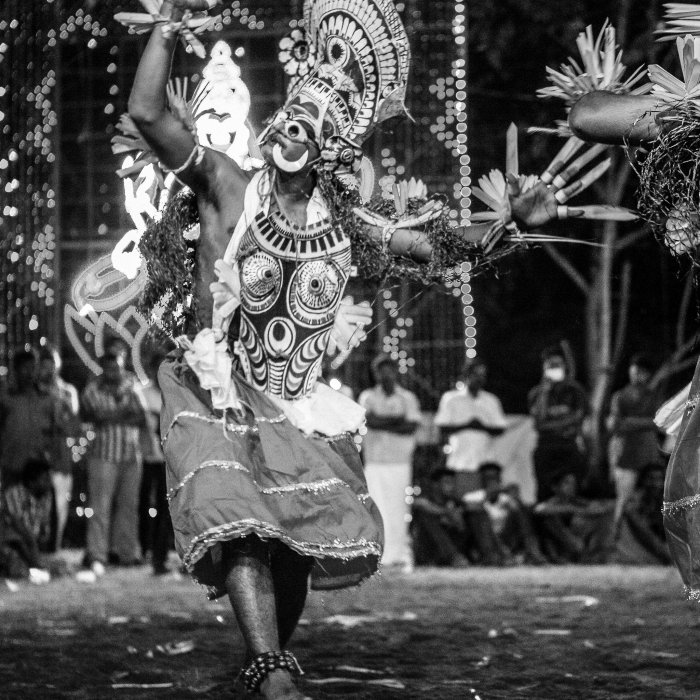 Maya Yakshi from Elanthoor, 2016 What is seen as new today, in selecting a range of "significant movements" quoted from a rural genre, was perhaps declared obsolete there, a long time ago. What we find "new" may belong to the restrictive notion of "tradition"; besides, we should take into account the tendency of the dance vital force, which is to eliminate boundaries of arbitrary classifications. These complex issues were illustrated in one of the boldest statements of Western dance culture, bringing to our memory "a riot" reported, in rejection of "The Rite of Spring - Pictures of Pagan Russia", created at the dawn of Modern dance [7] (Paris, 1913). Vaslav Nijinsky's ambition was to change the language of ballet, not to rejuvenate it, but to bring it up to a new paradigm. His focus was riveted on the mystical commitment of performance. It was important for the artist, eager to divinize the figure of man towards nature realms, to modify drastically vocabularies and techniques from the ballet medium he mastered so easily. Dancers stomped the ground to install trance in the breathing process; they used a circle symbol as the central figure. Nijinsky introduced callisthenic jumping, arms akimbo; plus an intricate handwork with asymmetrical port de bras; feet pigeon-toed; altogether a range of unusual material, reconstructed with a new vocabulary distant from ballet language. To get there, the choreographer borrowed rural items collected from old "folk" Russian motives, used as a thread for the argument. "A young woman villager is offered to gods; the lady finally surrenders to the group, in a trance"; this was the main plot. The way Nijinsky choreographed the woman soloist accessing to trance (a rather long sequence) could only be the amazing allegory of a body state brought forward as the main figure, irrespective of conservative expectations. It's important to stress today that Nijinsky's choreographic vision was impossible to carry out properly, considering Stravinsky's narrow choice of composition he made by using a regular rhythmic mode (and silence), which entrapped Nijinsky's vision. However the event reached sensibilities. There were those who thought it was a masterpiece, and the others convinced it was rubbish. Added with the ban of body trance in the name of public morals, there is no doubt that the Rite of Spring was indeed a manifesto for dance modernness. The most salient element, looking at Joffrey Ballet reconstruction (1987) of The Rite of Spring in the USA, remains the displacement of techniques inspired by shamanistic bodies on to the grounds of Western ballet aesthetics, without any further questionings over the specific musical devices being used, which avoided the real trance to happen. In Paris earlier version, the piece was supposed to preserve the taste of a privileged class, back then the exclusive audience of ballet productions. Owner of the company, Diaghilev's artistic intentions would probably not deliver any hint over how "free" dancing bodies should act to create a change of perception; nor try to raise body issues with their emotional implications; nor recognise this piece as a deep game changer. A revolution happened on stage, which left Parisians half-puzzled. Lady dancer's trance was a simulation, and the rip off of a big chunk of what dance goals are all about, a problem left open for performers to explore afterwards. In that time in Paris, to bring a so-called "obscene material" to the Théâtre des Champs-Elysées, created a landmark for new trends to come, liberated from normative attitudes. But, once opening the path to "modern" dance currents, how could such a radical experience like trance, so essential to dance, be simulated and disappear from the field of further experimental, "contemporary" productions? Were we considering the status of "natural" practises performed in a modern context in Europe, an ambiguity rises considering the body state of the doer involved, and the social impact dance has created. What stands for us at the origin of a "modern" dance project (it could be Duncan celebrating nature, Nijinsky evocating trance, or Wigman portraying a witch), any item relating to "unconventional body behaviours", created by Western avant-garde, gets even more interesting to focus on if we then consider the full trance process performed in Indian culture, via the Mask technique ("full" trance is also a matter of disputes agitating temple life). What should not be done physically "to avoid hurting sensitivities" (so local commentators assert, to avoid developing on the trance taboo) stands at the heart of quarrels involving "natural behaviours", the focus of action for a freer body technique. Comparing the need in Paris to get to the sensation of a successful "worship ritual", to the Indian rural case where trance is performed as a technique, every cultural vision relating on quality of a "nature connexion" remains worthy of consideration. Willingly uncontrolled trance holds a psychological function and an aesthetic coherence in rural conditions. This is how, among other genres, the Southern style of the genre Padayani is defined in Middle Travancore. Originally a popular asset of dance rituals with common features uniting villages participating to the cult, trance as a technique comes in three types of sacrifices, with Adavi (sacrifice by fire), Chooral Adavi (sacrifice by thorns) and Thullal (sacrifice by dance). Trance relates to the sacred genre through singing in order to operate a change in perception, via senses.  Adavi by thorns from Venpala, 2018 We know the rural genre has maintained close musical links with local patrimonies over history. Even so, should a classical essence be called to evolve in contact with rural productions, like for the pair Kathakali/Padayani, the mould of a new genre proves categories are not antinomic at all. The two registers work together, but a duality resists when we start considering the "religious curative aspect" of rural performances once they get mixed with classical (margi) aesthetics. Figures tend to be uneasy to emerge if you don't insist enough on the spiritual aspect of rural performance, the kind of energy it requires. The method needs to be acted, but it shouldn't be a simulation. It implies for the performer a subtle task: not their elimination but a steady control of the mind on top of emotional states. It needs to be expressed through the text, to succeed in reaching the rural cosmography. The cultural treasure expressed in the ancient Mask technique happens to be a topic to explore insofar to grasp the genre as a spiritual art form - as in a modern archaism; and a social event that needs to be performed through its very fracture. By observing, in parallel, the interest of Contemporary currents for rural productions, we find, frequently, artists foreigners who may pick a mood, or try to "copy" the attractive content of their choice (it goes from Kalaripayat "snake design" to Kathakali stupendous theatrical presence). The idea is to help capture the strange appeal of cultural items perceived and performed in their tribal/odd/exotic environment, without embracing de facto a group anthropology with its own stories that need to be lived directly in the flesh. The enterprise would probably take years of teaching (ashans add with humour; "and lives of practice for the body to integrate as a body knowledge"). South Indians are high formalists when it comes to rhythm matters. Dancing steps are as important as the visual aspect of the Mask artefact, though different from one village style to the other; "writing" involves a whole organisation (special families are allowed to collect and process the bark from the trees, and each team owns a design style). "Writing" makes the divine body exist. This is when we begin to realise that there can't be a thing like an "intercultural process" elaborating surely in learning a culture from outside, by simply imitating movements. In Padayani, the rhythm structure that belongs to the Mask remains the central interest. Borrowed in the absence of creed, or missing visualisation techniques by lack of verbal transmission, we get the feeling that folk live components with their "rhythm-defined characters" could not possibly be "appropriated" [8] by "borrowers", be reshuffled in new formats, or even be "understood" by dance creators, for what they aim to. In addition, rural aesthetics are carrying with them a number of class model projections this is what the regional catalogue reveals. The use of typical, yet controversial Western words like "folk" or "folklorism", so much anchored today in Kerala culture after British colonisation, does not help either clarifying how a rural body could design the local belief. It exposes users to misunderstandings because it occults by habit the actual richness of the spiritual content, shared by all, whatever the class or caste one belongs to, despite the various standpoints different conceptions of body traditions transport in history. Still there's a much deeper level of cultural influence on Travancore territories. We find a diversity of artistic encounters occurring between two main body cultures: the Pre-Dravidians current, still prevailing today, and the Brahminic culture through colonisation. Performing arts have been blossoming there in a traditional way, thanks to an exterior imitation of sorts throughout centuries. Slowly, rural genres were becoming "classical" for many reasons. The long process of cultural colonisation we can trace like a living archaeology has kept on modifying original beliefs dated from the Pre-dravidian times [9] . Its influence contributes to the ongoing transformation of the Mother cult into a Hinduist cosmography, although both cultures hold different visions over how embodiment of identities should be performed. Techniques keep manifesting two different roots, two basic models, to express two distinct corpo-realities (corporéité, Michel Bernard) that may be hidden by other technical challenges. While I was invited to his rehearsals in the 90's, Director Kavalam Narayana Panikkar explained to me how he used to tap at length into rural rhythm patrimonies for the Sopanam theatre group (1998),though he never engaged the creed of his actors when they performed Padayani steps. Performing a real Padayani was not his concern. Trance either, as a body state, was hardly "borrowed" by any Indian artist or stage director. Full trance seems to be appreciated on its home grounds, only by connoisseurs. A collision of values occurs on the rural stage at the moment the body gets "unleashed" (and therefore becomes dangerous as a performative act), while supposed to set everyone in the assembly free from psychological burdens. 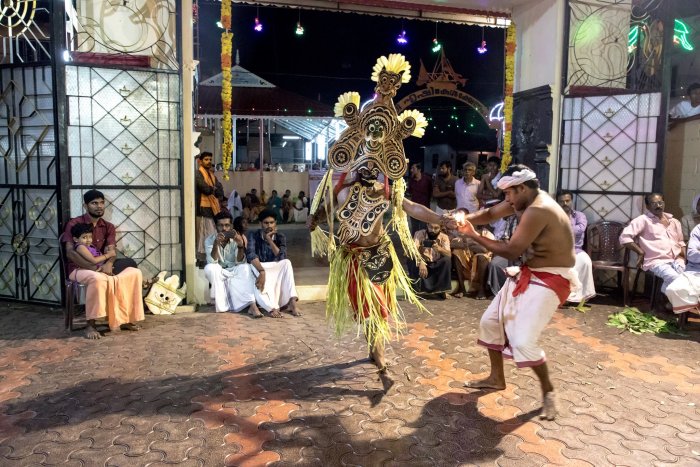 Kalan Kolam from Kadammanitta, 2018 For me, there was a paradox on the side of rural representations that I could handle once I had introduced my Western categories in my Indian observations. As a postmodern dancer trained in Western dance culture, yet fully included in a traditionalist rural group, namely the Gothra Kala Kalari (implying I had to perform publicly), I had a recurrent impression that rural performers were not only bringing their traditions on stage, they were also able to bring their performing skills to the forefront of newness: something in the performance which was never seen before. A new flower opens and exposes its complete newness. Every time, every day a new aspect of nature will attract life and ensure through flower blossoming the cycle of life. Like that, performers would bring to each performance a minute alteration, a small change inside the manifested form. It could be a new element to the Mask: the weight of a long black wig thrown in the air. Suddenly it underlines another rhythmic aspect; and it modifies the sense of space and time. While performing in an altered state of consciousness, artist-dancers would dissociate successfully the physical alliance of "a repetition of some traditional figure, and newness". They can go from a memory bank of entropic images in cohorts it conveys, to a different perception of a new artefact they are setting forward. You could call it "the Danced-Theatre of Trance"; the piece Kalan Kolam (forty minutes long) is noteworthy in that respect. Long ago, upon a phase of recreation, rural artists and their teams decided they would "borrow" a few scenographic devices inherited from the classical danced-theatres that is; immobility, frontal postures towards the audience, the art of a specific recitation taken from the musical format of Kathakali genre, without giving up their wild spiritual techniques. In terms of theatre dramaturgy, the lead rural singer would deliver a plot worth to classical tragedy standards, while the rural Mask would engage in an exorcism with unprecedented symbolic violence, using trance; that mode including the entire assembly of spectators. 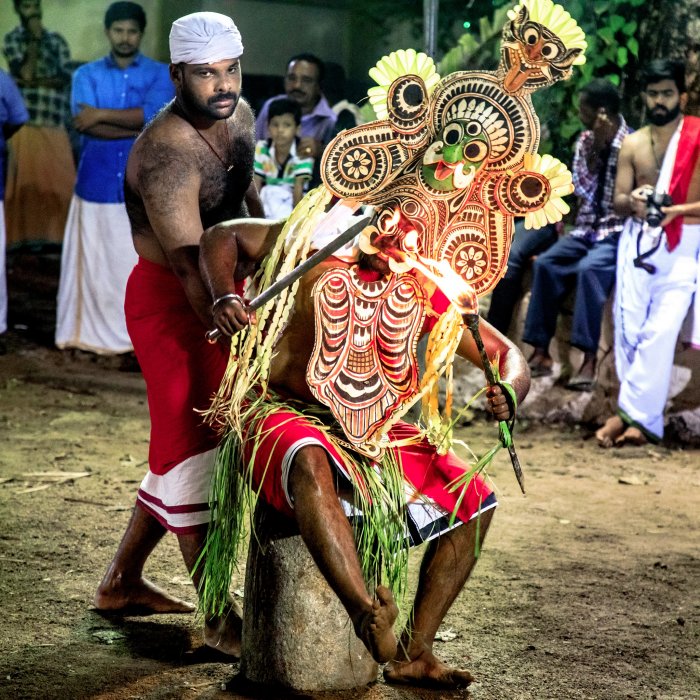 Although, we note that to the blending of classical components the new genre has adopted by borrowing an argument from the Brahminic heritage (the victory of Shiva-Markandan), has been added a psychological level of action which targets the audience. It works with an uncanny feeling it instils. Here modernness - again - the intuitive innovation this formal change creates in the rural masterpiece, would allow the artist to fully operate on people senses. One could say the genius of transformation was made possible as soon as these two genres specificities were gathered in a different performing formula, a seemingly refreshed math equation; eventually getting too strong, softened and self-censured, it could become misplaced nowadays, when the audience consists occasionally of urban workers enjoying a pack of limited entertainment programmes picked from rural grounds and transplanted in city prosceniums. Contrary to that, performing the Mask Kalan Kolam at its original place "proves to be efficient as a true ritual dealing with main death (trespassing) issues, and time". The method highlights the anthropological possibility, and the best proximity for the performer to confront with a familiar audience he knows so well from his childhood, and with whom he could transact properly as an authentic archetype, "written" from head to feet, and become the exclusive agent working inside the empire of human affects. Reciprocally, the exorcist aspect of the rite involving body trance, a delicate matter in public venues, remains notoriously absent among classical danced-theatres, or if they do, trance is highly codified and controlled. Genres keep on recalling myths and legends falling under the epistemology of a classical culture (Mahabharata, etc.), including a peculiar dance canon. Barely, by imitation, the rural notion of a "Pre-Dravidian Mask" might be roughly adapted to a few classical registers -the makeup sequence for instance, a ritualised preparation in Kathakali, which remains far from rural Mask concerns. Yet, as long as the "folklore" dance heritage will be considered in dancers' mind as a "little tradition within the great tradition" [10] , rural artists could be denied any chief influence on regional art productions. No sense of major aesthetical shifts in regard to the "power control" on stage could be granted to them.  Naga Yakshi from Venpala, 2018 Especially when ritual objectives depend on technical ability an oral culture requires in order operating at the body level. For a pre-Dravidian eye, ritual actions relate to "Nature syllables", whose "letters" are to be found at the tip of nadis -the body energetic channels. "Letters" are made "efficient when being audible"; they can act on the "cosmic level" of human perception. A few idioms offer the same kind of spiritual bond activated through physical action. "Sanskrit is more musical and weightless. Tamil is more 'big bang' based; it is strong, with more sounds. Malayalam is a mix of both Tamil and Sanskrit" (Reghukumar Ashan). We note that other idioms based on 26 letters alphabet do not carry comparable body "opportunities", or technical possibilities, meanwhile rural performers can bring a digital finger connexion to a body sensation in a verbal stanza, and know how to keep a continuum between physical action and the musical text, simply by connecting hand-and-foot-work with the text. What happens in the minds is another story. A genuine theatre definitely takes its roots here. While immersed in the Pre-Dravidian scene, the background frame gets wider and digs itself like a sinkhole. Someone has created an echo by calling the spirits of nature, and they started "changing perceptions" in the audience. In a moment, one must empty out a whole ocean of sense memories to unravel the body that speaks. 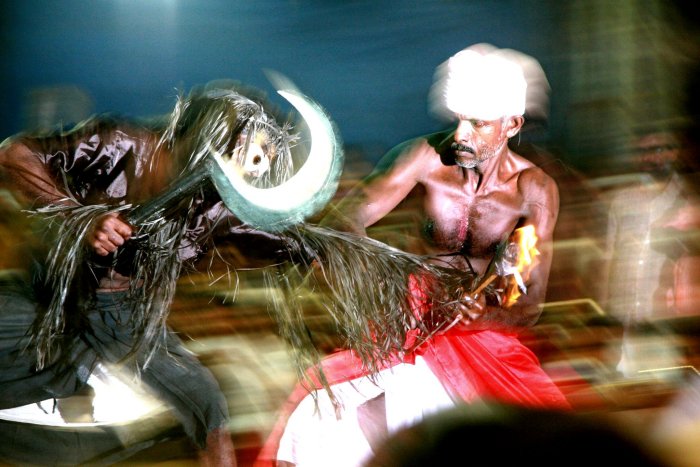 Kuratti from Kadammanita, 2008 At the time of Thullal sacrifice, I noticed over the years a few Masks were tempted to "adjust" their performance with meaningful events from the societal context-it's the case of Kuratti- a Mask piece which highlights the cruel Mother behaviour towards her devotees. Twenty years ago at Kadammanitta center, Kuratti Kolam used to be performed by the Kuravan community, a scheduled caste. The Mask, dressed in black, engaged soon in hysteria. She (the Goddess) would run and menace people close with her scythe. Nowadays that the piece is also given in Northern centres, with a different way to perform and more energy spending, each performing season brings modifications. Without changing the initial set of rhythms, the set looks like it is thoroughly being changed. 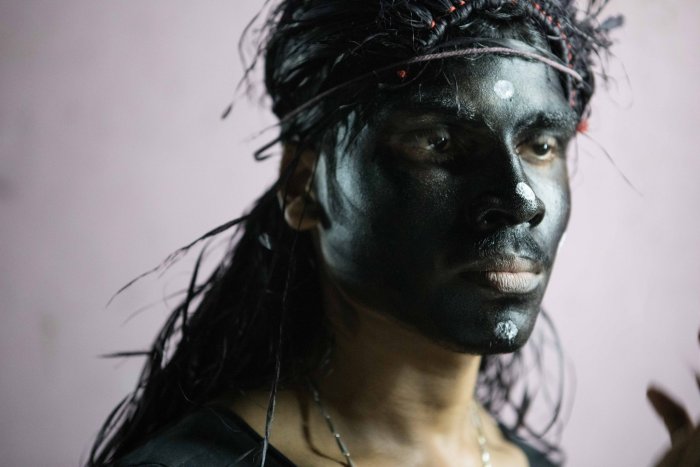 Kuratti from Venpala, 2018 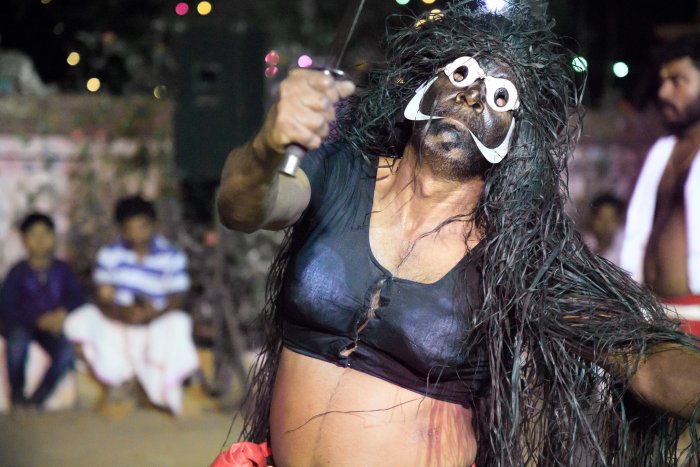 Kuratti from Venpala, 2019 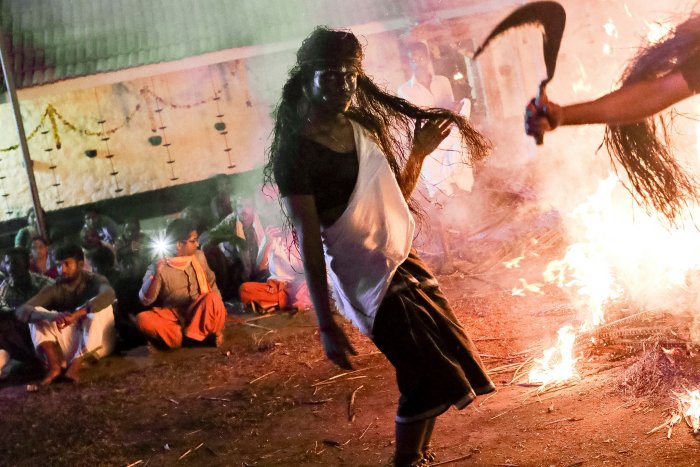 Kuratti from Kottangal, 2018 Once the Nair community from Kadalimangalam had decided they would perform Kuratti a few years ago, the piece became much longer and although it is not a rule, it got enhanced with additional choreography. In the most recent versions, dramatisation has been accentuated. Even if we sense no improvisation in steps, we do see performances based on the loop attack/protection, coming along, merging again and again, against the flow of percussions. Side characters are being "magnified" by means of innovative topographies. The level of energy is building up. A strong sexual drive designs the dancers' body state; this is the character of the Goddess (always performed by men). One Kuratti becomes four Kuratti, crazy on stage. Their developed choreographies, until it all explodes in a trance, may signal through stunning sequences the need of unceasing readjustments like social fights and existential claims agitating the representations of the group. 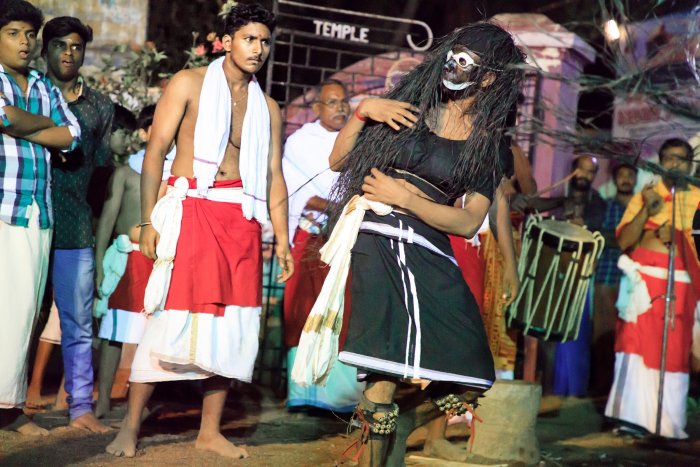 Kuratti from Kadalimangalam, 2019 My attention gets focussed on details. I notice odd moves to the performers, the way Masks use their eyes; how and where eyeballs are gazing through organic spectacles. Intangible "deals" sneak across collective actions. Something alien to our understanding could be negotiated in plain sight, so blatantly one may not realise it immediately. The Masks assembly is reuniting. It takes the aspect of a phenomenon, like fragments of an agrarian meaning recollecting with loud crashes. The spiritual involvement rural dancers deploy is about to transcend all narratives, deciding in fine who's looking at? And what are we looking at? In the piece Marutha (the Other Mother), the deity has decided to perform a thorough rice ventilation with a large basket. The overall sound system is deafening. She picks the youngest performers-kids running around, sit them down and breastfeed them; a few "ladies" carefully sweep the floor. Every village (22) through daily occupations, with infinite variations, shed as many lights over the Mask. 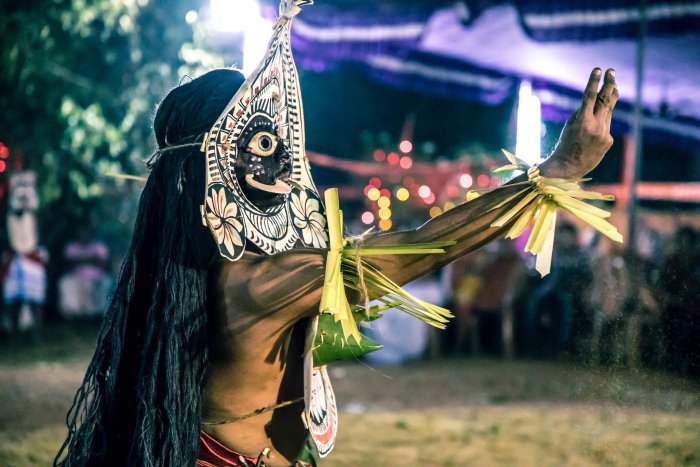 Marutha from Eraviperoor, 2019 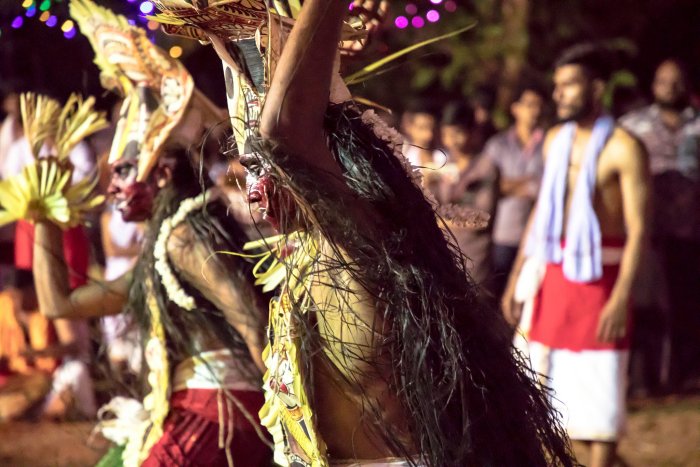 Naga Yakshi from Venpala, 2019 In Kerala, there is enough room "in the lab" for many experiments. Aesthetics are maintained whether one decides to perform the existing repertoire, or create a new Mask. The image of a monster will be modified through a much-discussed design, until all agree on the final sketch of a new kolam; the flavour of tradition shall remain in-pulsed. Sudheesh, a student from Ezhumattoor village was showing me once a sketch of a Mask half-tiger, half-monkey. His ashan suggested a few modifications towards what "he felt the Mask should look like". Years before, Sudarshan Ashan had told me his project; «This year (2016), I decided I would create a new item [11] , it will be «Ambara Yakshi» - Yakshi of the Sky. I designed the Mask. My inspiration came from some Kathakali figures (a classical genre), which I re-interpreted in the language of Padayani. Costumes and steps are mine; rhythms were taken from our rural heritage. The piece is 20 minutes long.» Aside of tradition, simultaneously a cultural change slowly begins to bring the young generation on different roads. Kids try new things. They found the good feature to implement new styles."R&B people" will embody Afro-American beats. They expend their dance practises to the sound of the "Bollywood blender", in search of "a harmony between the East and the West"; they say this new trend should be ideally performed un-staged. For these amateur dancers-kids, contemporary dance means you're "rocking" to worldly urban rap and hip-hop rhythms, commonly denominated in South India, cinematics, or DJ dance. American artist rapper Jay Z [12] declares; "Rap means what's new. It's how to be the coolest, the hottest; it's about the gift of discovery." New dance is also coming on proscenium stages with a more theatrical approach. Special Indian figures show how influences are beginning to work globally with the concept of contemporary dance -"la Danse Contemporaine", is a term officially coined in Paris (1975), one of the world cultural windows for art. What is new? What is contemporary? All cultural matters being considered "state matters" in the French tradition of centralisation, the denomination "Contemporary dance" was approved following the reflexion of a few dance professionals and members from the personnel of Secretariate of Culture: a handful of observers whose common project was to structure the Western hype [13] , with an innovative mould and economic interests. La Danse Contemporaine was a vast project, still less funded, and different in nature from the Opéra Garnier management, the full state controlled institution that ruled from its beginning (1669) the evolution of French classical répertoire. The state was the largest purveyor of funds for the Opéra Ballet House treasury management. Comparing today the social classes these two models were aiming to target; the former, traditionally devoted to the educated bourgeoisie through ballet teaching; the latter, la Danse Contemporaine, actually designed to reach lower classes (the suburbs) was meant to create choreographic newness, which implied nothing less than "pushing" cultural contents on demand. Contemporary dance was to be state-wise monitored by a statement of public policy, and the creation of recruiting agencies like D.R.A.C. (Regional Direction of Cultural Affairs, since 1977), whereby, the state offered to provide the status of "occasional entertainment worker" to dancer artists who, most of them were living in precarious conditions. Concerning the institutional frame and the implicit "fundamentals" of contemporary dance creators, state agencies brought a special clause about the way choreographers were supposed to develop their project, in order to be eligible for fund raising. The idea was that anyone would be considered a dance creator as long as the dance project kept being the singular expression of an individual research (Louppe; Germain-Thomas [14] ). What we can argue today is that beyond providing bold aesthetic productions, there was hardly any basis for a piece to possibly last in time and be hand-over to the next generation, other than by video-collecting or labanotating the movements. Dance was conceived as an endless progression of "newness fabric", giving emphasis to princeps choreographers over common uses of dance companies, working more in duration their artistic collective habits as a team work. Certainly, there is what dancers call the passing (la passation), or the teaching of dances, via movement reproduction between professionals. However, could we assert a movement transfer is equivalent to a transmission? And what would be transmitted anyway? The state was the ultimate referent, the producer, therefore introducing financial dependency with the artist; it became the selector and the advisor among other qualifications, with the intervention of due nominated "dance inspectors" (les inspecteurs de la danse). The French reform of "la Danse Contemporaine" had favoured an institutional approach of dance. It sat a milestone towards a controlled creation of body expression, a cultural fact that in no way can be minimized. Artist dancers were asked to apply to a state exam sanctioned by a state diploma, in order to teach "contemporary dance classes". Contemporary dance had changed into a word-bag with a contradictory polysemy for the following forty years. It was the blueprint for those who had joined the "French New dance" current, including the first adepts of Neo-ballet style, Serge Lifar, Maurice Béjart. At the same time, French Nouvelle Danse was standing far away from the American "postmodern" revolution; it was far from its tutelary figure, the most modern of choreographers, Merce Cunningham, who cleared in New York City during the Sixties, a path for the rebellious dancers of the Judson Church era. Actually, one may wonder if it was ever possible for the French Head Secretariate of Culture, following Michel Guy's empassionate taste for American dance, to have American dancers teach French dancers how to be "postmodern" in their minds? The agenda of cultural politics was set for another model of dance, virtually unlimited in France. It was made apt to travel abroad with cultural missions to sub-Saharan Africa, amidst ex-colonial French territories (Bourdie [15] ), to mark a new cultural legitimacy. "La danse contemporaine" was present in the region of Maghreb, with projects including local artists (Khaddour from Théâtre National d'Alger, 1980). French politics had denunciated for a long time the colonisation practices ("Visages de Femmes" - Women Faces - by Les Ballets Modernes de Paris, 1973). Through an abundance of state projects, local dancer artists would spread actions at home, driven by a message encouraging their emancipation: the altruistic desire of "sharing movement" with others. The exported scene of "Contemporary" (Le Contemporain) offered opportunities to explore ways to embody the "freedom of dance creation". Artists were trained to "dialog" and "opening up one self to the other". Like verbal communication, using gesture collectively would help the process to get socio-contagious. Not to mention the anti-colonial reactions from African dancers criticizing the interference of contemporary dance on indigenous cultures. Artists would be reluctant to an essentialized "Contemporary dance" notion, many of them looking forward to a redefinition of cultural identities. Something we would call an anthropological flaw emerges from an ideal construction of new currents. The term "danse contemporaine" appears to be controversial at its original place, France, half a century later. A shortage of genuine transmission techniques is the most revealing marker of "non influences" applied to dancers belonging in the following generation. The anomaly is manifesting by a lack of aesthetical influence and the absence of a federative mind (les écoles, les tendances, les styles), except through state guidance. The "unconstructive" design remains a pre-requisite to its understanding. For the holders of the Contemporary scene, such posture could be stated as a rule: "My dance style is different from other's, and all are meant to be this way [16] ." Another concept would come up after the "first principle". It would be called "Non-dance"(La Non Danse; Massaro, Bel). The new concept denied the need of any technical knowledge to solve dance issues. However, the process of movement transmission that Mauss describes in Body techniques [17] , shall apply equally to any trained dancers. It maybe by visual influence or by apprenticeship; it will work by impregnation. Eventually, it will let itself identify through an observation, revealing the remaining traces of a "body style signature" printed in gestures, despite the person's will. The Eastern European inheritances of Modern dance for instance: Hellereau, and the Swiss heritage of Emile Jaques-Dalcroze. And more: the German influences, with Laban and Wigman. In France: the odd "print" of Georges Demeny/Irène Popard collaboration [18] (la technique Popard - 1920), who promoted gym exercises shown by sportsmen that became popular among French women from upper middle class. The effect it created, allowing "expressivity", would finally twist every element of "l'expression corporelle" [19] . An awesome part of French dance "modern" heritage was still visible in all its intricacy within the dancers' manners. Bodies' habits would manifest the origin of their formation without a doubt. Fashion keepers from the next wave decided to snub that substantial heritage. "Contemporary dance" was the "correct" denomination. Instead, the accumulation of influences held the seeds of a few characteristic body-behaviours we may describe as the idiosyncrasies of Contemporary dancers, shown in teachings and performed in dance classes. We may name them with time pass: the resurgent old-fashioned mannerisms, their dramaturgy carried on with a tension between two poles. On one hand, the attraction for the American Postmodern dance current (De Keersmaeker), notably its initial period through Judson Church era influence (the 60's), from which Contemporary dancers took many clichés and stereotypes (walking, tasks, props, chance) failing to grasp the initial concern these strategies were reflecting in the transformation of American culture. "Borrowings" and appropriations would work, while new schemes of creativity would exhaust the counter-culture models carried by American Postmoderns. There was a fascination for the European legacy, inherited from famous creators, German choreographer Pina Bauch, and Polish theatre director Tadeusz Kantor. Both influences created an irresolute tension infused in many productions. Choreographer Mathilde Monnier, director of the Centre National de Danse explains the impossible choice she couldn't resolve, based on her personal dance itinerary [20] . We try to look for the offsprings of contemporary dance era, and predictably we find none [21] . However idiosyncrasies are travelling by imitation. A gestalt subsists among the living tissues of contemporary productions, implying the desire of "sharing emotions with the audience"; an attraction for floor work; the mania of collective trampling; the use of silence as a musical basis (which could be a dance nonsense); body contact (inspired from Contact improvisation, another American postmodern technique) without studying the initial cultural context; and body "expressivity" a highly problematic notion. Today, forty years after the dance reform that Montanari astonishingly abnegated in France, probably in a superior way compared to any other art, dance is still able to deliver instantly the flavour of its time. Being naturally expressive, a timeless requirement, is not simple to figure out, because of the ties dance has maintained with dated theories, like dance studies on the Labanian form, and the concept of "space" that Laban successfully taught in European schools. Laban was not educationally trained as a dancer; he was a student in architecture, interested in dance, then he became a theoretician of dance. Choreographer Trisha Brown, vigilant to any "contemporary" manipulation, eager to distinguish the American and the European heritages, would tease her French fans by reminding them she had "never been a Labanian and (philosophy must have a hard time with dance), she had never read Merleau-Ponty". Educative programs including a heavy use of kinesiology (Pilates, F. M. Alexander), showed how caught up in concepts and ideas the new dance scene had evolved, so much "Contemporary dance" might exclude in the long run the transmitting phenomenon of affiliations and the notion of transmission, as long as the individual experience of dance would be the most significant asset of dance creativity. Undoubtedly not the reflection of common suffrages, the term "contemporary dance" has showed its paradoxical capacity to refer to a sense of universalism (a French familiar world-spreading notion inherited from Les Lumières) only when monitored by state will, careful in cultural politics as means to an end, boosted with lobbies influence. The term "danse contemporaine" remains difficult to isolate as a travelling ethnocentrism, since it can expand at any place its aura of "the new". The ideal recipient of a "dance possibility" would undermine the opportunity for the dancer to be consciously and viscerally engaged in an anthropological transformation of its group, with patent social implications.  Velichappadu from Venpala, 2017 Paris, February 2022 This article is under copyright© Note: We kindly inform our reader that due to pandemic policies, Padayani rituals were maintained, although the public not allowed at venues, for two consecutive years, 2020 and 2021.  Member of Padayani Gothra Kala Kalari Kadammanitta since 1998, Marc-Paul Lambert is an ethnoscenologist (anthropologist specialist of performing arts); he graduated in Modern dance from Bennington College in USA (BA), and got his PhD from Paris Vincennes Saint Denis University. Marc-Paul Lambert is the first dancer from the West who ever enrolled in an Indian sacred rural art form. Ethnoscenology Laboratory, Paris Vincennes Saint-Denis University Contact: sundara2004@yahoo.com Footnotes: 1. LAURENCE LOUPPE, Poétique de la danse contemporaine, Contredanse, La Pensée du Mouvement, 2004, p. 63. 2. ANNETTE LEDAY, Contemporary Dance in India Today a Survey, with the support of the Centre National de la Danse, Paris (Aide à la recherche et au patrimoine en danse) 2019. 3. PATRICK GERMAIN THOMAS, conference at l'École des Chartes, February 24, 2017. 4. BHASKAR PARICHLA, All You Wanted to Know About Contemporary Dance in India, November 13, 2017, in the magazine MARG, Mumbai. 5. SADANAND MENOON, What is Contemporary Dance trying to say? The Hindu, April 18, 2018; « I was reminded of this a few days ago, reading a piece by contemporary dancer Astad Deboo who said, of his latest collaboration with dhrupad musician Bahaauddin Dagar, that his dance 'means what I make it means'. » 6. Les enjeux du marché de l'art mondialisé - Intégration des nouveaux acteurs et « globalisation forcée » ; Grenoble Ecole de management, Note hebdomadaire d'analyse géo-politique, Comprendre les enjeux stratégiques, October 12th, 2014. 7. Sources, Boris Kochno, Mémoires du siècle, « Boris Kochno Diaghilev's collaborator », FRANCE CULTURE, September 9th, 1989. Kochno mentions frequent clashes between Nijinsky and Stavinsky. Their argument referred to an "un-adequate" way of rendering Nijinsky's choreographic intention, musically. 8. Sociologist ERIC FASSIN reports in an interview, Le Monde, 24/08/ 2018: "The notion of "appropriation" appears for the first time in English, at the end of the 20th Century in the artistic field, as a theoretical concept created to analyze 'cultural colonialism'. Bell Hooks, an important figure of Black feminism, illustrates at the beginning of the 1990's the notion of 'appropriation' with a predatory metaphor: 'to eat the Other'." 9. MARC-PAUL LAMBERT "The embodiment of rural identities - The Predravidian heritage", 2017. On the Predravidian current, see "Padayani Rural Tantras - The Aesthetics And Embodiment Of Beliefs And Identity", May 19th 2013. 10. The quote is part of a definition given by anthropologist Joann Wheeler Kealiinohomoku to define dance folklore. Sourced by SALLY BANES in Terpsichore in Sneakers Post-Modern Dance, « Deborah Hay: The Cosmic Dance », p. 124; Wesleyan University Press, 1987. 11. "Ezhumattoor Sudarsan Ashan said « it is new » - it is new only at Ezhumattoor; 'Ambara Yakshi' is an old form belonging to Padayani - what he created in his centre is a totally different form of traditional 'Ambara Yakshi'"», says REGHUKUMAR ASHAN. 12. Interview with Dean Baquet in The New York Times style magazine, as the executive editor, September 29th, 2017. 13. "Enfin Une Scène Pour La Danse contemporaine : Le Concours Chorégraphique De Bagnolet", a documentary by PERRINE KERVRANE, ANNE FLEURY, 16 July 2013, France Culture, (48:15). 14. "The "fundamentals" of contemporary dance are centered on the creative process rather than on its result. Priority is given to authenticity of anatomical progression, which starts with an individual impulse, then crosses the corporeal matter, and is embodied in a constructed form without reference to an external model. The process is subject to a conscious control and exploration -the extent and the depth of which remain the essential part of technical work. Created from an infinity of possibilities, that is to say: without being dependent on any pre-existing codes, body movement expresses a thought, at the opposite of any mechanical reproduction." by PATRICK GERMAIN-THOMAS, The Contemporary Dance Policy: A Co-Construction By The Public Bodies And Distribution Channels, in Quaderni, Hiver 2013-2014.ap. 15. ANNIE BOURDIE Créations Chorégraphiques d'Afrique Francophone : Systèmes de Représentations Et Stratégies De Reconnaissance En Période Contemporaine, PhD thesis, October 21st 2013, Ecole doctorale Culture et Société. 16. Author's note: Obviously, there was a body revival in the air, blowing with a different tone compared to May 68', and waiting for social changes to achieve the young generation aspirations, which happened during a political shift from the right wing to socialist Mitterand. French society was bustling in claims, citizens openly discussing rights, freedom of expression, emancipation, and gender minorities' recognition. Many artists were experiencing a mindful living body with a greater sense of social unity. In fact each Parisian dancer had either experienced, at least once, a "Weather Laboratory" workshop on outdoor events supervised by Japanese performer Min Tanaka; - either tried Cunningham technique with Robert Kovich at Paris American Centre; - either became familiar with "Einstein on the Beach", an American production financed by French State. One could be working in the morning on 'minimal' steps under the direction of Andy De Groat who settled in the capital; - another one would enjoy the same day a class of Afro-beats with Elsa Wolliaston. This is what Paris looked like in these times; "Everyone you were meeting was a choreographer", says dancer J.C. Gallotta. 17. « Body Techniques (Les Techniques du Corps) » was primarily a lecture given by MARCEL MAUSS, May 17TH, 1934 before the Société de Psychologie; it was published for the first time by the Journal de Psychologie, vol. xxxii, No. 3-4, March 15th April 15th, 1936. 18. Jeannine Lorca (Présidente de l'Association Nationale Irène Popard), « Les mouvements de Demeny "complet-continus-arrondis" dans la Méthode Irène Popard ». Deuxième Semaine Internationale du Corps 2017. Journée d'étude du Mardi 27 juin 2017: "Demeny-Hebert- La Nature en Mouvement". Coordination: PIERRE PHILIPPE-MEDEN. 19. Author's note: We, French dancers in the 1980's, were accustomed in our training to the use of a word-alliance "l'expression corporelle" to signify a specific body behaviour applied to the dance medium. "L'expression corporelle" (bodily expression) was popular in the 1960's and is still currently used. The term "expression corporelle" curiously takes its full meaning in a gym-fitness context, for historical reasons. Today, the State is controlling gymnastics teachings ("gymnastique sportive") under the directives of National Education ministry, Chapter ("Les activités corporelles d'expression", Serge Le Bihan, PIUMF - IUFM La Rochelle, September 2006); the program is based on the idea that it is possible for individuals to "express feelings" in motion. 20. Tadeusz Kantor legacy lives in each of my dance pieces. I participated once in a famous masterclass he gave in Charlevilles-Mezières; I had to fight to be a part of the internship. It turned out that I decided to leave the class just after a week; I had told myself that if I stayed any longer, for the rest of my life I would forever copy the style of Tadeusz Kantor. " Mathilde Monnier in Les Masterclasses par Arnaud Laporte, 15 June 2018; France Culture. 21. Author's note: Although Les Carnets Bagouet (a transmission dance project) were an exception, we wonder how possible it was for the new generation following WW2, to evolve to this point? Jean-Paul Montanari", Director since 1983 of Montpellier Danse festival, a front figure of la Danse française, managed for decades the biggest budget of contemporary dance. A superior member of the National Council of Dance, he abruptly declares to medias on June 3rd 2016: "Contemporary dance died with its own generation"; then commenting on dancers who belonged to the baby-boomers wave: «Such criteria referred as choreographic writing, movement, exploration of the space concept, are no longer the core of interest for new generations. The "Non Dance" movement in the 90's was already the sign of it. However we are heading towards another story. Those people inhabited by the need to dance represent the "tail of the comet"; it is the end of a conceptual "device" (un dispositif) planned for the treatment of body motion, a long time ago. It once corresponded to us (the "baby boomers", Editor's note), but it no longer fits with the actual trend. » Published in the local press la Gazette de Montpellier. The interview is amplified in national press medias; Télérama « Arts et Scènes ». Article by EMMANUELLE BOUCHEZ, 29/06/2016. Post your comments Pl provide your name and email id along with your comment. All appropriate comments posted with name and email id in the blog will be featured in the site. |